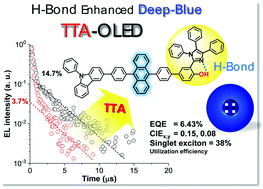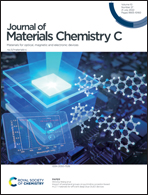Deep-blue high-efficiency triplet–triplet annihilation organic light-emitting diodes using hydroxyl-substituted tetraphenylimidazole-functionalized anthracene fluorescent emitters†
Abstract
Herein, two new triplet–triplet annihilation (TTA) molecules, namely HO-PIAC and PIAC, as deep-blue emitters for high-efficiency TTA-OLEDs were designed and synthesized. HO-PIAC and PIAC contain 4-(N-phenylcarbazol-3-yl)phenylanthracene as a blue emissive core directly functionalized with hydroxyl-substituted tetraphenylimidazole and tetraphenylimidazole, respectively. Their structural, physical, and photophysical properties were experimentally and theoretically examined. Both molecules exhibited deep-blue color emissions in solution and neat films, with decent hole mobility and high thermal and electrochemical stabilities. Intense TTA emissions were seen in their thin films (2 wt% doped in poly(4-bromostyrene) (PBS) films covered by a polyvinyl alcohol (PVA) film). The two molecules were effectively utilized as emitters in OLEDs and both devices displayed deep-blue electroluminescence (EL) spectra (CIEy ≤ 0.08) with a narrow full width at half maximum of ≤59 nm, low turn-on voltages (3.0–3.3 V), and TTA characteristics. In particular, the HO-PIAC-based device attained a superior EL performance with a maximum luminance (Lmax) of 7042 cd m−2, a maximum external quantum efficiency (EQEmax) of 6.43%, a maximum current efficiency (CEmax) of 2.64 cd A−1, and a singlet exciton utilization (ηs) of 38%.



 Please wait while we load your content...
Please wait while we load your content...